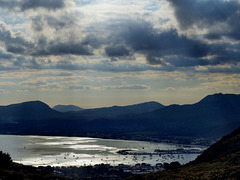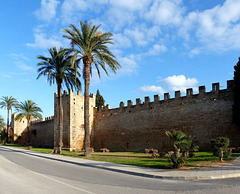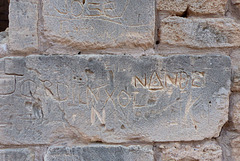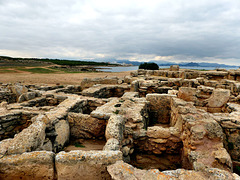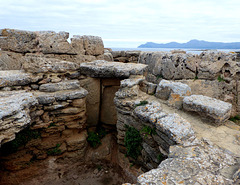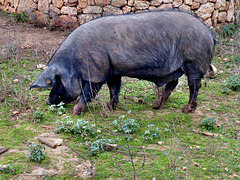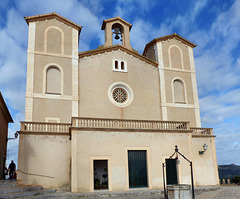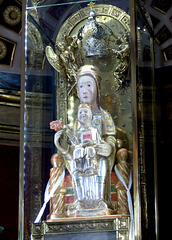
Mallorca
Not "A Winter in Mallorca" - only two weeks in winter.
Port de Pollença
| |
|
Mallorca is the largest island in the Mediterranean Balearic Islands, which are part of Spain. Mallorca is an extremely popular holiday destination. The Palma de Mallorca Airport, one of the busiest in Spain, is used by about 30 million tourists per year.
After the fall of the Western Roman Empire, the island was invaded by the Vandals in 425. The time of the Vandals ended, when Byzantine troops general took the island in 534. The first Muslim arrivals were in 707. These ended the Byzantine domination and established their own hegemony. Until 903, the island was part of the Umayyad Caliphate.
From Between 902 and 1229 the island was under Islamic control. James I of Aragon ( aka "Jaume el Conqueridor") conquered Mallorca in December 1229.
Port de Pollença, located about 6 km east of Pollença, was a small village of fishermen before the tourism started. Just like Pollença it attracted many artists in the first half of the last century. In 1935 Agatha Christie published a short story titled "Problem at Pollensa Bay".
Alcúdia
| |
|
Mallorca is the largest island in the Mediterranean Balearic Islands, which are part of Spain. Mallorca is an extremely popular holiday destination. The Palma de Mallorca Airport, one of the busiest in Spain, is used by about 30 million tourists per year.
After the fall of the Western Roman Empire, the island was invaded by the Vandals in 425. The time of the Vandals ended, when Byzantine troops general took the island in 534. The first Muslim arrivals were in 707. These ended the Byzantine domination and established their own hegemony. Until 903, the island was part of the Umayyad Caliphate.
From Between 902 and 1229 the island was under Islamic control. James I of Aragon ( aka "Jaume el Conqueridor") conquered Mallorca in December 1229.
The Romans had founded a flourishing town just south of today's Alcúdia. This town got sacked and destroyed by the Vandals in 426.
When Moors and Arabs took over the power of the island, the settlement did not exist any more. So the Moors "refounded" it, but it did not gain much importance. At the time of the Aragonese conquest of the island in 1229 by King James I of Aragon, this was only an estate, which the king ceded to a vassal. A settlement formed around the estate, which was first mentioned in a protocol from 1282. It then became a parish and centre of administration in 1298 under King James II of Mallorca (Jaume II). That year the construction of the city wall started. It was completed in 1362 and - as you see - parts of which are still preserved.
Alcúdia
| |
|
Mallorca is the largest island in the Mediterranean Balearic Islands, which are part of Spain. Mallorca is an extremely popular holiday destination. The Palma de Mallorca Airport, one of the busiest in Spain, is used by about 30 million tourists per year.
After the fall of the Western Roman Empire, the island was invaded by the Vandals in 425. The time of the Vandals ended, when Byzantine troops general took the island in 534. The first Muslim arrivals were in 707. These ended the Byzantine domination and established their own hegemony. Until 903, the island was part of the Umayyad Caliphate.
From Between 902 and 1229 the island was under Islamic control. James I of Aragon ( aka "Jaume el Conqueridor") conquered Mallorca in December 1229.
The Romans had founded a flourishing town just south of today's Alcúdia. This town got sacked and destroyed by the Vandals in 426.
When Moors and Arabs took over the power of the island, the settlement did not exist any more. So the Moors "refounded" it, but it did not gain much importance. At the time of the Aragonese conquest of the island in 1229 by King James I of Aragon, this was only an estate, which the king ceded to a vassal. A settlement formed around the estate, which was first mentioned in a protocol from 1282. It then became a parish and centre of administration in 1298 under King James II of Mallorca (Jaume II). That year the construction of the city wall started. It was completed in 1362 and - as you see - parts of which are still preserved.
All the soft stones around the gate are covered with graffiti.
Alcúdia
| |
|
Mallorca is the largest island in the Mediterranean Balearic Islands, which are part of Spain. Mallorca is an extremely popular holiday destination. The Palma de Mallorca Airport, one of the busiest in Spain, is used by about 30 million tourists per year.
After the fall of the Western Roman Empire, the island was invaded by the Vandals in 425. The time of the Vandals ended, when Byzantine troops general took the island in 534. The first Muslim arrivals were in 707. These ended the Byzantine domination and established their own hegemony. Until 903, the island was part of the Umayyad Caliphate.
From Between 902 and 1229 the island was under Islamic control. James I of Aragon ( aka "Jaume el Conqueridor") conquered Mallorca in December 1229.
The Romans had founded a flourishing town just south of today's Alcúdia. This town got sacked and destroyed by the Vandals in 426.
When Moors and Arabs took over the power of the island, the settlement did not exist any more. So the Moors "refounded" it, but it did not gain much importance. At the time of the Aragonese conquest of the island in 1229 by King James I of Aragon, this was only an estate, which the king ceded to a vassal. A settlement formed around the estate, which was first mentioned in a protocol from 1282. It then became a parish and centre of administration in 1298 under King James II of Mallorca (Jaume II). That year the construction of the city wall started. It was completed in 1362 and - as you see - parts of which are still preserved.
Sa Pobla
| |
|
Mallorca is the largest island in the Mediterranean Balearic Islands, which are part of Spain. Mallorca is an extremely popular holiday destination. The Palma de Mallorca Airport, one of the busiest in Spain, is used by about 30 million tourists per year.
After the fall of the Western Roman Empire, the island was invaded by the Vandals in 425. The time of the Vandals ended, when Byzantine troops general took the island in 534. The first Muslim arrivals were in 707. These ended the Byzantine domination and established their own hegemony. Until 903, the island was part of the Umayyad Caliphate.
From between 902 and 1229 the island was under Islamic control. James I of Aragon ( aka "Jaume el Conqueridor") conquered Mallorca in December 1229.
Located in the centre of Sa Pobla´s cemetery is since 1899 this very nice round funeral chapel.
Son Real
| |
|
Mallorca is the largest island in the Mediterranean Balearic Islands, which are part of Spain. Mallorca is an extremely popular holiday destination. The Palma de Mallorca Airport, one of the busiest in Spain, is used by about 30 million tourists per year.
After the fall of the Western Roman Empire, the island was invaded by the Vandals in 425. The time of the Vandals ended, when Byzantine troops general took the island in 534. The first Muslim arrivals were in 707. These ended the Byzantine domination and established their own hegemony. Until 903, the island was part of the Umayyad Caliphate.
From Between 902 and 1229 the island was under Islamic control. James I of Aragon ( aka "Jaume el Conqueridor") conquered Mallorca in December 1229.
The necropolis of Son Real is located on the small headland "Punta des Fenicis" (Fenicis - Phoenicians) on the Badia d'Alcúdia ("Bay of Alcúdia"). Seen in the backdrop is Port d'Alcúdia.
The necropolis dates from the 7th to 4th centuries BC. Archaeological excavations on the site began after the discovery in 1957. Over the next decade, more than 100 graves were unearthed and the remains of about 300 bodies and many funerary objects were found.
The origin of those buried in the necropolis is unclear, as no associated settlement has been found to date.
Son Real
| |
|
Mallorca is the largest island in the Mediterranean Balearic Islands, which are part of Spain. Mallorca is an extremely popular holiday destination. The Palma de Mallorca Airport, one of the busiest in Spain, is used by about 30 million tourists per year.
After the fall of the Western Roman Empire, the island was invaded by the Vandals in 425. The time of the Vandals ended, when Byzantine troops general took the island in 534. The first Muslim arrivals were in 707. These ended the Byzantine domination and established their own hegemony. Until 903, the island was part of the Umayyad Caliphate.
From Between 902 and 1229 the island was under Islamic control. James I of Aragon ( aka "Jaume el Conqueridor") conquered Mallorca in December 1229.
The necropolis of Son Real is located on the small headland "Punta des Fenicis" (Fenicis - Phoenicians) on the Badia d'Alcúdia ("Bay of Alcúdia").
The necropolis dates from the 7th to 4th centuries BC. Archaeological excavations on the site began after the discovery in 1957. Over the next decade, more than 100 graves were unearthed and the remains of about 300 bodies and many funerary objects were found.
The origin of those buried in the necropolis is unclear, as no associated settlement has been found to date.
Cases de Son Real
| |
|
Mallorca is the largest island in the Mediterranean Balearic Islands, which are part of Spain. Mallorca is an extremely popular holiday destination. The Palma de Mallorca Airport, one of the busiest in Spain, is used by about 30 million tourists per year.
After the fall of the Western Roman Empire, the island was invaded by the Vandals in 425. The time of the Vandals ended, when Byzantine troops general took the island in 534. The first Muslim arrivals were in 707. These ended the Byzantine domination and established their own hegemony. Until 903, the island was part of the Umayyad Caliphate.
From between 902 and 1229 the island was under Islamic control. James I of Aragon ( aka "Jaume el Conqueridor") conquered Mallorca in December 1229.
The hiking trail to the necropolis Son Real started at the "Cases de Son Real", a kind of public finca. The museum was closed, but the local animals were all outside. Here is one of the black Iberian pig (cerdo ibérico), known for "Jamón de Pata Negra", a prime-quality ham.
Artà
| |
|
Mallorca is the largest island in the Mediterranean Balearic Islands, which are part of Spain. Mallorca is an extremely popular holiday destination. The Palma de Mallorca Airport, one of the busiest in Spain, is used by about 30 million tourists per year.
After the fall of the Western Roman Empire, the island was invaded by the Vandals in 425. The time of the Vandals ended, when Byzantine troops general took the island in 534. The first Muslim arrivals were in 707. These ended the Byzantine domination and established their own hegemony. Until 903, the island was part of the Umayyad Caliphate.
From between 902 and 1229 the island was under Islamic control. James I of Aragon ( aka "Jaume el Conqueridor") conquered Mallorca in December 1229.
Artà was known as a settlement in Moorish times and got first mentioned in 1232 under the name Yartân. From the 16th to the 18th century the population of the city rose sharply and, in addition to agriculture, it developed a textile industry. An outbreak of bubonic plague in 1820, that killed nearly a third of Mallorca´s population, caused a setback resulting in 1200 deaths.
Seen to the right is the parish church.
Artà - Santuari de Sant Salvador
| |
|
Mallorca is the largest island in the Mediterranean Balearic Islands, which are part of Spain. Mallorca is an extremely popular holiday destination. The Palma de Mallorca Airport, one of the busiest in Spain, is used by about 30 million tourists per year.
After the fall of the Western Roman Empire, the island was invaded by the Vandals in 425. The time of the Vandals ended, when Byzantine troops general took the island in 534. The first Muslim arrivals were in 707. These ended the Byzantine domination and established their own hegemony. Until 903, the island was part of the Umayyad Caliphate.
From between 902 and 1229 the island was under Islamic control. James I of Aragon ( aka "Jaume el Conqueridor") conquered Mallorca in December 1229.
Artà was known as a settlement in Moorish times and was one of the last Moorish strongholds. It was taken in 1230 and first mentioned in 1232 under the name Yartân. Upon the hill, was a Mosque at that time. It got demolished and a fortification with strong walls got erected. In 1832 the "Santuari de Sant Salvador", that meanwhile is a place of pilgrimage, was built on top of the hill.
From the 16th to the 18th century the population of the city rose sharply and, in addition to agriculture, it developed a textile industry. An outbreak of bubonic plague in 1820, that killed nearly a third of Mallorca´s population, caused a setback resulting in 1200 deaths. The church of the Santuari de Sant Salvador was built in 1832, as the preexisting once had been used as a hospital during the plague and was burned down afterwards.
Artà - Santuari de Sant Salvador
| |
|
Mallorca is the largest island in the Mediterranean Balearic Islands, which are part of Spain. Mallorca is an extremely popular holiday destination. The Palma de Mallorca Airport, one of the busiest in Spain, is used by about 30 million tourists per year.
After the fall of the Western Roman Empire, the island was invaded by the Vandals in 425. The time of the Vandals ended, when Byzantine troops general took the island in 534. The first Muslim arrivals were in 707. These ended the Byzantine domination and established their own hegemony. Until 903, the island was part of the Umayyad Caliphate.
From between 902 and 1229 the island was under Islamic control. James I of Aragon ( aka "Jaume el Conqueridor") conquered Mallorca in December 1229.
Artà was known as a settlement in Moorish times and was one of the last Moorish strongholds. It was taken in 1230 and first mentioned in 1232 under the name Yartân. Upon the hill, was a Mosque at that time. I got demolished and a fortification with strong walls got erected. In 1832 the "Santuari de Sant Salvador", that meanwhile is a place of pilgrimage, was built on top of the hill.
From the 16th to the 18th century the population of the city rose sharply and, in addition to agriculture, it developed a textile industry. An outbreak of bubonic plague in 1820, that killed nearly a third of Mallorca´s population, caused a setback resulting in 1200 deaths.
Artà - Santuari de Sant Salvador
| |
|
Mallorca is the largest island in the Mediterranean Balearic Islands, which are part of Spain. Mallorca is an extremely popular holiday destination. The Palma de Mallorca Airport, one of the busiest in Spain, is used by about 30 million tourists per year.
After the fall of the Western Roman Empire, the island was invaded by the Vandals in 425. The time of the Vandals ended, when Byzantine troops general took the island in 534. The first Muslim arrivals were in 707. These ended the Byzantine domination and established their own hegemony. Until 903, the island was part of the Umayyad Caliphate.
From between 902 and 1229 the island was under Islamic control. James I of Aragon ( aka "Jaume el Conqueridor") conquered Mallorca in December 1229.
Artà was known as a settlement in Moorish times and was one of the last Moorish strongholds. It was taken in 1230 and first mentioned in 1232 under the name Yartân. Upon the hill, was a Mosque at that time. It got demolished and a fortification with strong walls got erected. In 1832 the "Santuari de Sant Salvador", that meanwhile is a place of pilgrimage, was built on top of the hill.
From the 16th to the 18th century the population of the city rose sharply and, in addition to agriculture, it developed a textile industry. An outbreak of bubonic plague in 1820, that killed nearly a third of Mallorca´s population, caused a setback resulting in 1200 deaths. The church of the Santuari de Sant Salvador was built in 1832, as the preexisting once had been used as a hospital during the plague and was burned down afterwards.
The Romanesque statue of the Virgin of Sant Salvador came from Bellpuig monastery and has been the patron saint of Artà since 1922.
Jump to top
RSS feed- Latest items - Subscribe to the latest items added to this album
- ipernity © 2007-2024
- Help & Contact
|
Club news
|
About ipernity
|
History |
ipernity Club & Prices |
Guide of good conduct
Donate | Group guidelines | Privacy policy | Terms of use | Statutes | In memoria -
Facebook
Twitter

